The New Dodge Charger Is Here: Daytona EV Coupe for 2024, Sedan and “Sixpack” Gas Model in 2025
America’s muscle car is entering a new era. This is the 2025 Dodge Charger. You may notice that this hulking two-door looks almost identical to the Charger SRT Daytona concept that broke cover in August 2022. That’s no accident—Dodge head honcho Tim Kuniskis made a conscious effort to put more or less the final design out in the open so it could marinate for 18 months in people’s minds. Now, the steak is ready to sizzle, and it’s coming in a few different cuts—electric, gas, two-door, and four-door.
Kuniskis projected deep confidence in the two new powertrains, which include a 100.5-kW battery with dual electric motors for the EV model and Stellantis’ new 3.0-liter twin-turbo inline-six for the gas model. “They told us we couldn’t sell Hemis,” Kuniskis said in a promotional video, shown to journalists at a Detroit location requested we keep secret, “but they never said they had to be boring and slow.”
Though there is no V-8 anywhere in the product plan, Kuniskis stands behind the new powertrains as a way “not to comply, but to compete.”
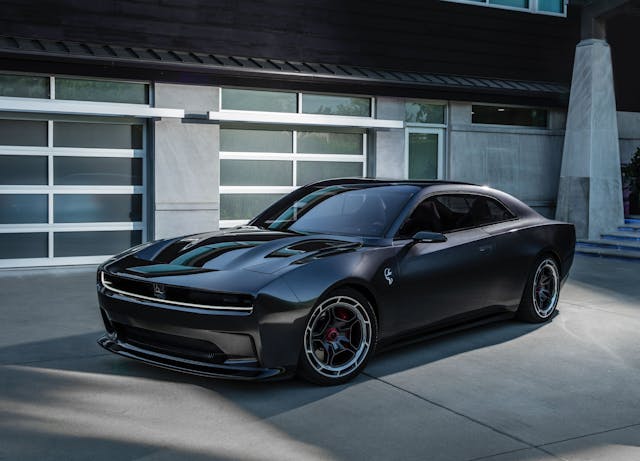

We had the chance to walk around and sit inside the new Charger coupe. It’s a great-looking machine with an imposing presence, differing from the concept car only in the side mirrors, door handles, B-pillar treatment, and wheels.
New Charger, New “Multienergy” Platform
Planned from the outset as both a pure EV and a traditional combustion-engine vehicle, the new Dodge Charger is the first-ever production model to use the STLA Large platform of parent company Stellantis. The platform supports both 400-volt and 800-volt architectures, with each electric drive module (EDM) consisting of a three-in-one motor, inverter, and gear reduction hardware.
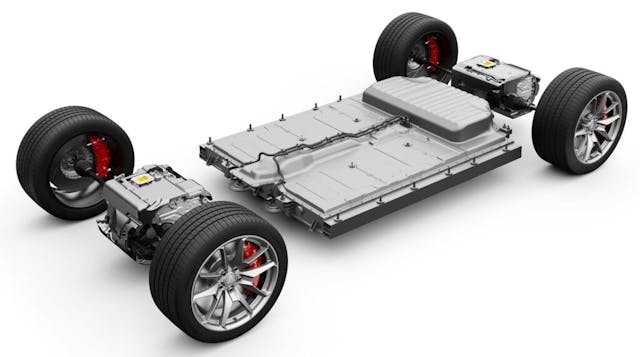
The initial run of Charger Daytona models will exclusively use a 400-volt system, but the forthcoming Banshee model—which the SRT Daytona Concept previewed—will employ the more powerful 800-volt system. All new Chargers will be built in Windsor, Ontario, Canada, with Samsung battery modules. They will initially be sourced from South Korea, though production is expected to move to the United States within a couple of years.
These same underpinnings will support six other new Stellantis vehicles under the Jeep, Alfa Romeo, and Maserati umbrellas.
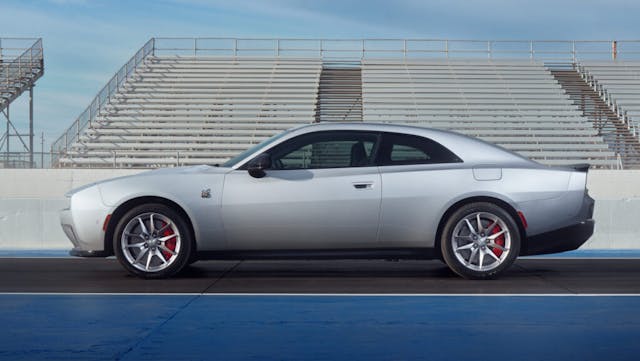
The overall footprint is 1.5 inches wider and a meaningful 8.7 inches longer than the outgoing Challenger Scat Pack Widebody, which means the new car is a sizable thing, indeed. Still, it doesn’t look ungainly. And Dodge designers did a remarkable job of integrating classic and modern design cues that both respect and evolve the outgoing design—arguably the most effective and enduring automotive design of the 21st century thus far. The full-width taillights, thick C-pillar, and squared-off front end read as recognizable Dodge cues, but with a futuristic treatment to replace the retro language. That the new car looks so good and also offers the utility of a liftback and a large trunk (22 cubic feet with the seats up, 33.3 with the rear seats folded) is a major achievement.

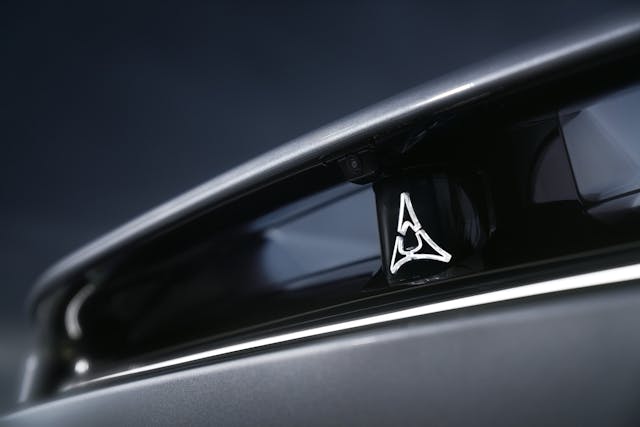
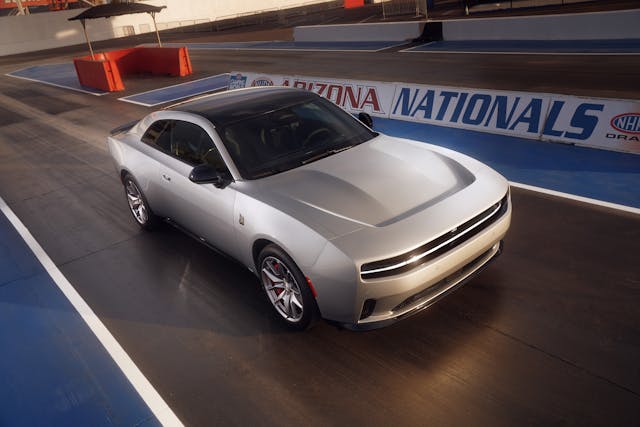
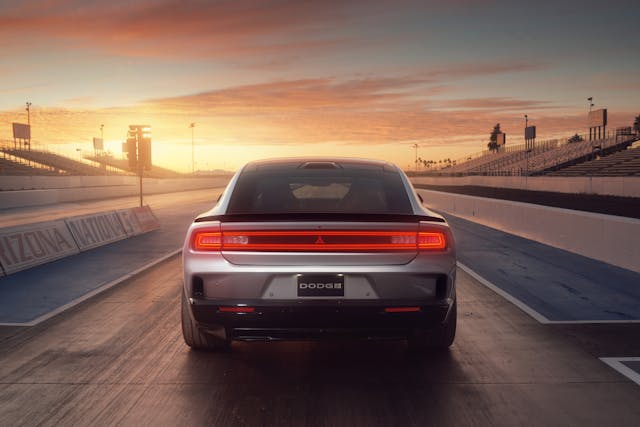
2024 Charger Daytona: Power, Suspension, Brakes
As expected, this new Charger will launch first with a pure-electric powertrain. That car, known as the Charger Daytona, will begin production in mid-2024 as a two-door coupe with a liftback-style rear hatch and seating for five.
Two models will appear at launch—the base R/T with 496 hp and the high-performance Scat Pack with 670. Max torque totals 404 lb-ft for the R/T and 627 for the Scat Pack. All-wheel drive is standard, courtesy of two identical electric drive modules (EDM), one for each axle, and independently capable of 250 kW (335 hp) and 314 lb-ft of torque. A standard mechanical limited-slip differential sits on the rear axle. Drivers will have the option to deactivate the front axle motor, enabling burnouts and donuts.
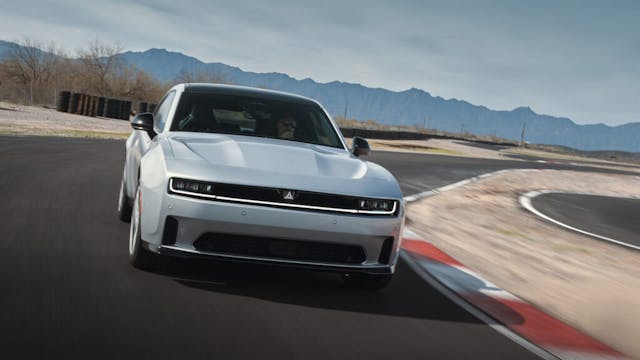
These initial Daytonas will come factory-equipped with Direct Connection upgrades. The standard Stage 1 kit for the R/T adds 40 hp (456 hp otherwise) and the standard Stage 2 kit for the Scat Pack adds 80 hp (590 hp otherwise). Later on, customers will need to buy these upgrade kits via Dodge’s Direct Connection performance catalog to unlock said power.
Drivers can experience maximum output from the twin electric motors but pushing the “Power Shot” button on the bottom right of the steering wheel. Power Shot adds 40 hp and lasts for 15 seconds, after which you’ll need to wait another 30 seconds to activate it again.
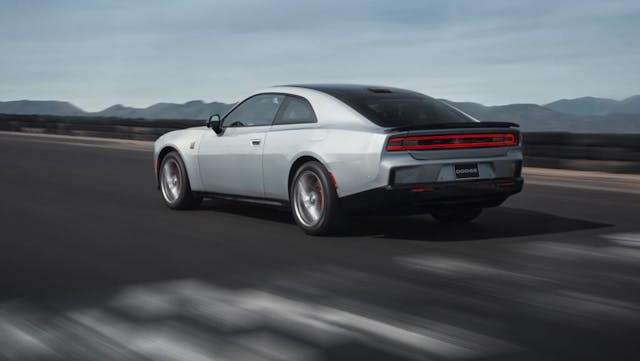
Dodge says the 0-to-60 sprint for the R/T Stage 1 model is over in 4.7 seconds, with a quarter-mile time of 13.1 seconds and a top speed of 137 mph. Scat Pack Charger Daytonas can do the same deeds in 3.3 and 11.5 seconds, on the way to a top speed of 134 mph.
2024 Charger Daytonas—both the R/T and Scat Pack—will also come with standard Track Pack stopping power: Brembo’s 16-inch, two-piece, vented front rotors with six-piston calipers and 16-inch, one-piece, vented rear rotors with four-piston calipers. Later Scat Pack models without the Track Pack will come with 15-inch brakes up front and 14s in the rear. Scat Pack Track Pack models feature 20-inch wheels and Dodge’s largest-ever tire package on a production model: Goodyear Eagle F1 Supercar 3s sized 305/35ZR20 up front and 325/35ZR20 out back.

All new Chargers come with multilink suspension all around. Daytona R/T models wear fixed monotube shocks, and Scat Pack models utilize the same setup with a higher spring rate. Those opting for the Track Pack version of the Scat Pack can expect dual-valve adaptive dampers on all four corners. Dodge was proud to point out that, compared with the outgoing Charger Scat Pack, there are three times as many accelerometers, four times as many ride height sensors, and four times as many wheel-hub accelerometers to monitor body position and handle various road conditions across all of the available drive modes.
Those drive modes include Auto, Eco, Sport, Wet/Snow, Track, and Drag (the last exclusive to Daytona Scat Pack). Within the Race Options menu there are a handful of special modes, such as Donut, Drift, Line Lock, and Launch Control. Race Prep mode sets an optimal battery temperature for the given conditions—cooler for road course lapping to allow the battery to heat up, and hotter for short bursts on drag strips.

2024 Charger Daytona: Battery, Range, Weight
Every Charger Daytona has a 100.5-kWh lithium-ion battery with a nickel-cobalt-aluminum chemistry. A big battery in a big coupe means a lot of weight: 5838 pounds for the R/T and Scat Pack alike. That is hundreds of pounds heavier than every starting weight for the 2025 Ram 1500, save the hybrid REV. For reference, the outgoing Challenger SXT tipped the scales at about 3800 pounds, while the Hellcat Redeye Jailbreak Widebody weighed 4445 pounds.
Kuniskis made a big to-do about how Dodge doesn’t care about range and instead optimized performance (because this is a MUSCLE CAR!), but buyers definitely care and want to know when they’ll run out of juice. The R/T Stage 1 is good for 317 miles of range and the Scat Pack Stage 2 for 260. Naturally, those figures will improve for future Daytona models without the standard Stage 1 or 2 kits.
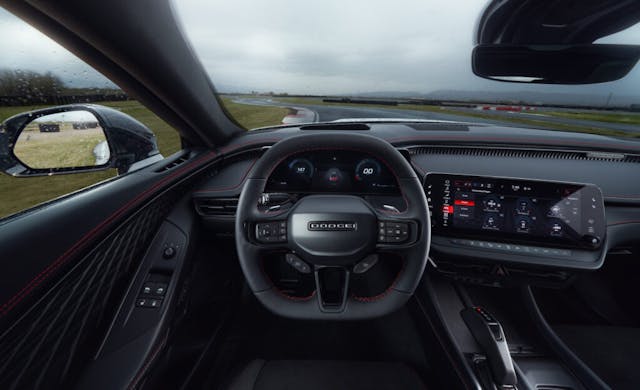
Using shift paddles on the steering wheel, drivers can adjust the regenerative braking force by selecting one of three levels.
Peak charging using a 350-kW DC fast charger is 183 kW, which can take the Daytona from 5 to 80 percent capacity in 32.5 minutes. Level 2 charging comes in at 11 kW. The standard plug is the CCS type, though Kuniskis hinted Dodge would soon reveal plans for an adapter that would permit access to Tesla’s Supercharger network.
Sixpack Power with Two or Four Doors
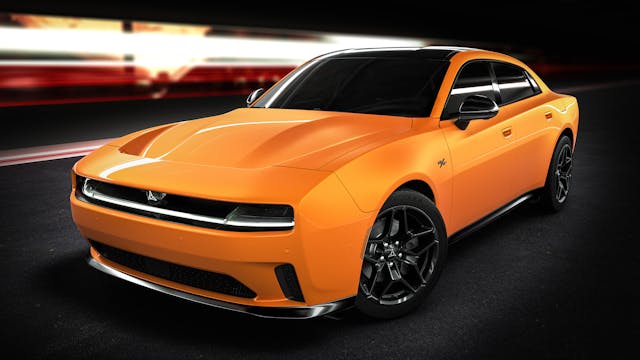
Combustion engine fans can rejoice, too. Prior rumors of a gas power proved true, and Dodge is calling this 3.0-liter Hurricane twin-turbo straight-six model the Charger Sixpack. When it joins the lineup early next year as a 2025 model, the Sixpack will also come in two states of tune: the base-model S.O. (Standard Output, 420 hp) and the high-performance H.O. (High Output, 550 hp). Every Sixpack comes with an eight-speed automatic transmission and all-wheel drive.
Kuniskis was adamant that the new Hurricane motor outperforms the old Hemi in every metric.

Sedans fans can rest easy knowing that the four-door Charger is back, also coming in early 2025, at the same time as the Sixpack. Four-door models will be available both in gas and electric form and the same output options as the two-door.
Slick as the two-door Charger looks, the four-door is even better. We only saw a design prototype, rather than a finished production model, but it has a powerful presence in person. It is somehow both imposing and impressive, though those attributes take nothing away from its elegance and sophistication. For my money, it’s the best-looking design out of Auburn Hills since the modern-era Chrysler 300.
2024 Dodge Charger: Interior and Infotainment
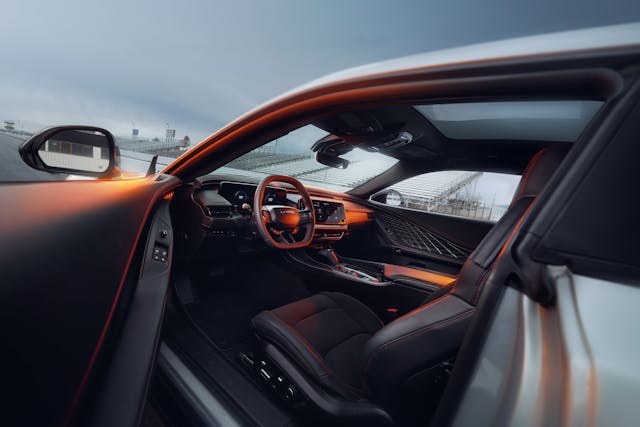
The new Charger’s interior is basically exactly what we saw on the SRT Daytona concept two years ago, minus the full-length center console and dual rear bucket seats. Fans of the vintage Charger may delight to hear that the vertical-slat pattern and texture on the instrument panel are meant to evoke the famous ’68 grille. Another classic touch is a new interpretation of the pistol-grip shifter. We’ll reserve final judgment once we can operate it for real, but after sitting in a very early production prototype at the reveal event, we can confirm it looks the business and feels good in the hand.
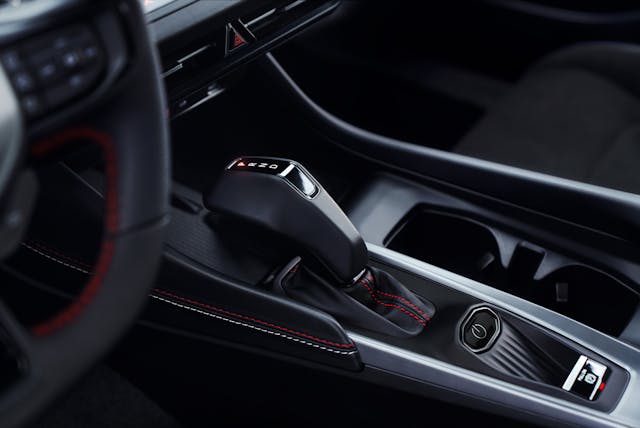
The steering wheel is big and fat, with a flat bottom and flat top that frames the optional 16-inch all-digital cluster. (A 10.25-inch screen is standard.) The center screen is a 12.3-inch unit showcasing the fifth generation of Stellantis Uconnect infotainment software. A row of physical buttons below the center display handles climate duties, and there is a knob for music/radio volume.
An electronic mechanism operates the doors of the 2024 Charger. There is a familiar external door handle, but inside the car you operate the mechanism via a button on the door. For those fearing being stuck inside the car with a dead battery, there is a redundant manual lever to disengage the latch that’s located on the bottom of the door card, near the footwell.
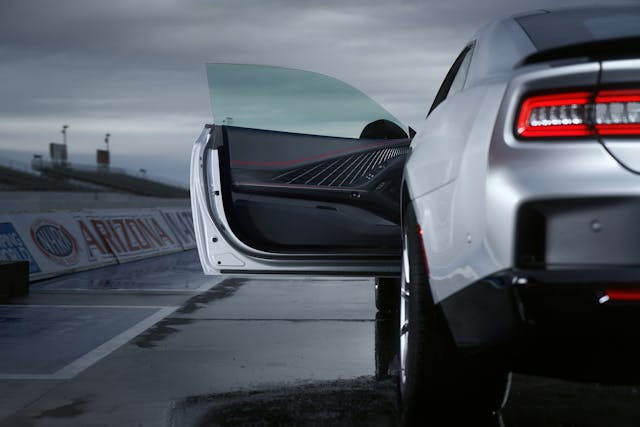
The materials in the top-trim, pre-production model (with Nappa leather) we sat in felt about on par with or a little better than those in the current Alfa Romeo Giulia and Stelvio. To be clear, that is a big, big step up from the interior of the outgoing Charger/Challenger. The cabin is not downright luxurious, but the feel is firmly in premium territory, and everything in sight looks fantastic. Our only complaint is that there is no way to fold the rear seats while standing behind the trunk opening—no automatic button or physical lever. Lowering the rear row requires reaching past the front bucket seat into the second row.
“Fratzonic” Chambered Exhaust
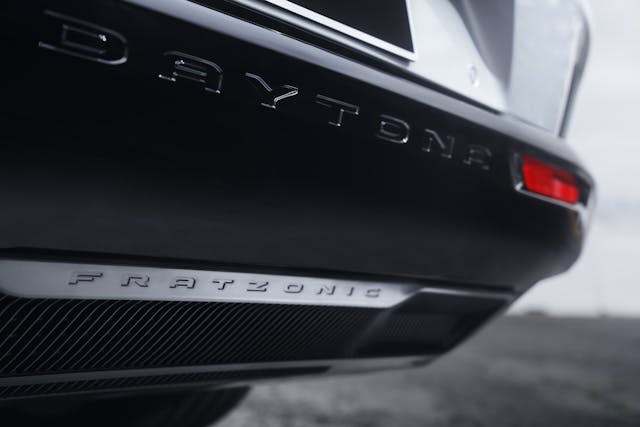
Perhaps the most controversial feature of the 2022 SRT Daytona Concept was the Fratzonic Chambered Exhaust. It’s an actual exhaust chamber that functions as a resonator for sound generated by speakers. The noise, Dodge says, will meet or exceed current Hellcat decibel levels and is engineered to mimic the cadence of a Hemi V-8.
We didn’t get to hear it at the Charger’s reveal event, a withholding which felt deliberate given the media’s unfavorable reaction to the initial sound back in 2022. Since then, Kuniskis said, the engineering team has worked through “hundreds” of iterations to get the sound just right. Chief Engineer Audrey Moore told Hagerty that for her it was the most fun part of the Charger project. (The toughest? Minimizing complexity and maximizing shared componentry between the two- and four-door Charger variants.)
The Charger Is Back, Baby
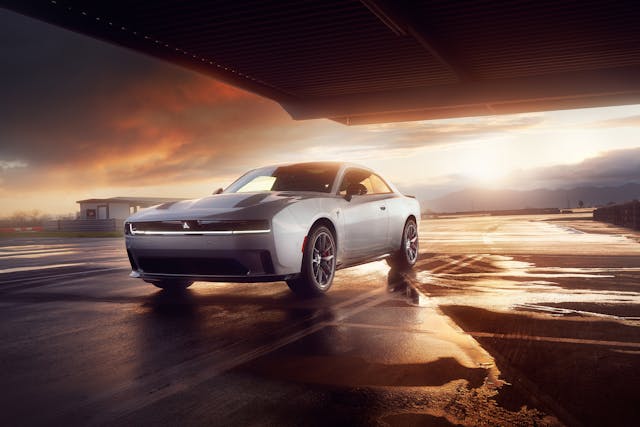
What the 2024 Charger will cost remains to be seen. Kuniskis told journalists that final pricing was still being enthusiastically debated at Dodge, so he refused to give even a shred of information on the subject. Given that all 2024 models will come with standard Track Pack brakes and Direct Connection kits, we expect a relatively high price compared with entry-level models that may trickle in down the road.
For now, it’s simply outstanding to see a new Charger coming our way. With the death of the Camaro, and the Mustang taking on more of a sports car role, Dodge has definitively cornered the market on the modern-day American muscle car. And, it seems wise at this juncture for Dodge to give people two avenues: dive in with both feet on an electric car or stick with a tried-and-true gasser. What’s more American, after all, than the power of choice?
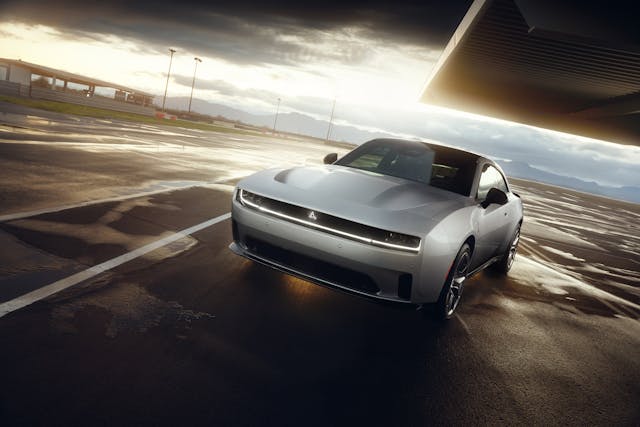
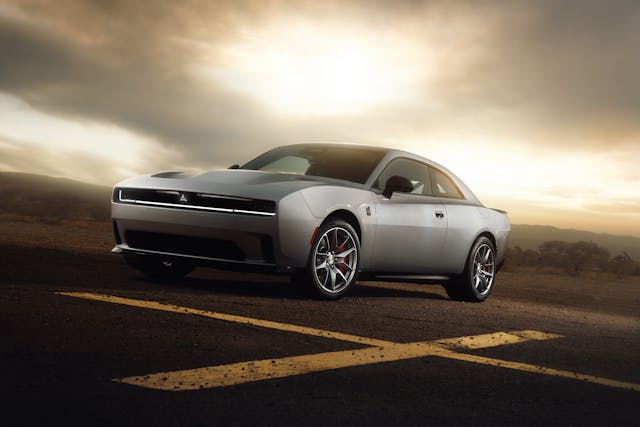
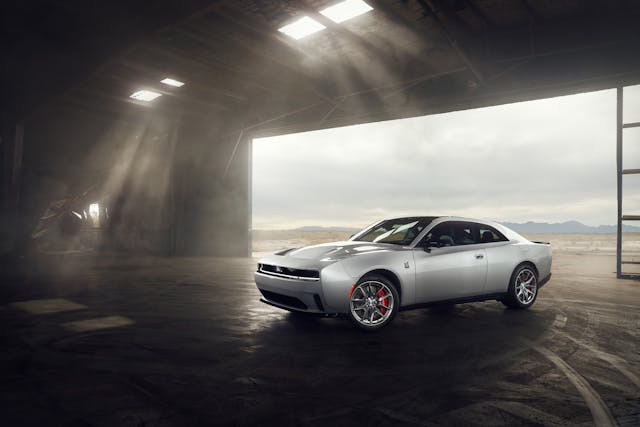
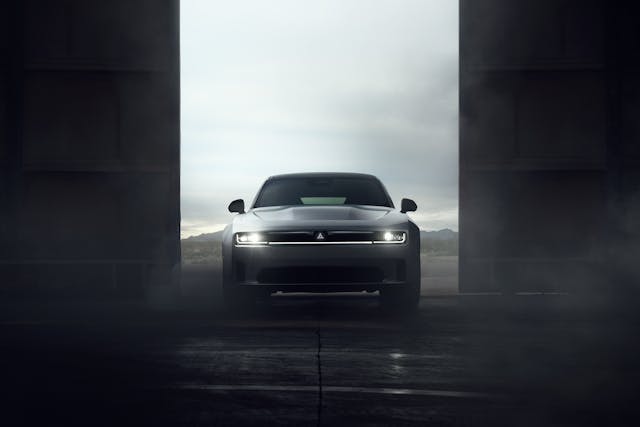
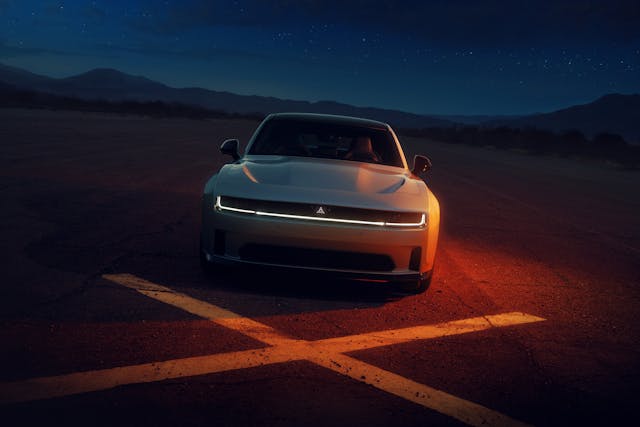

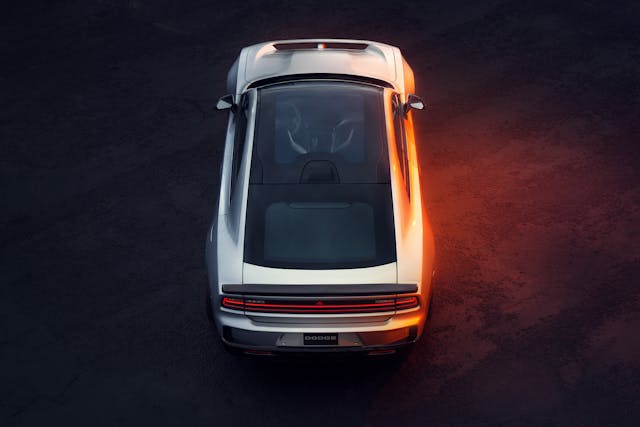
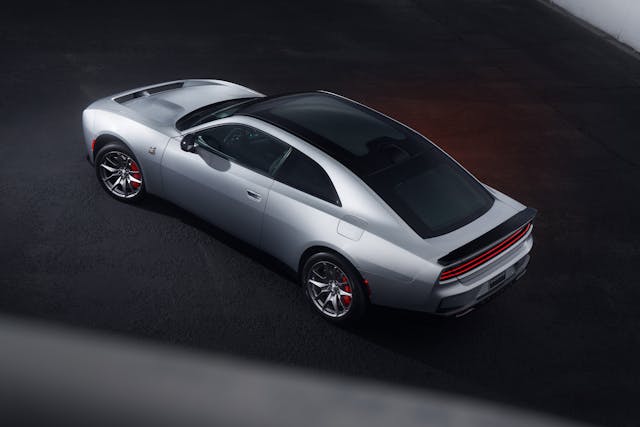
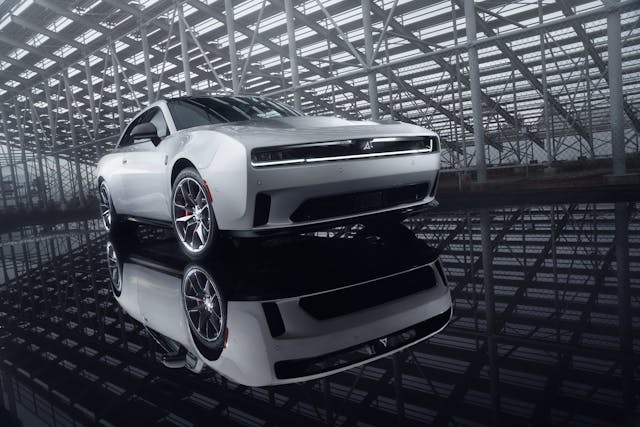


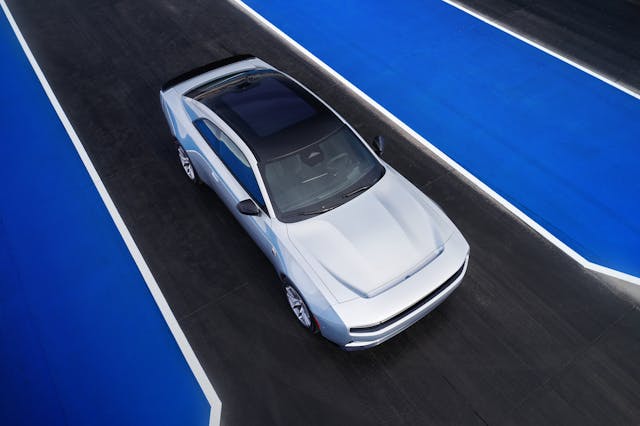

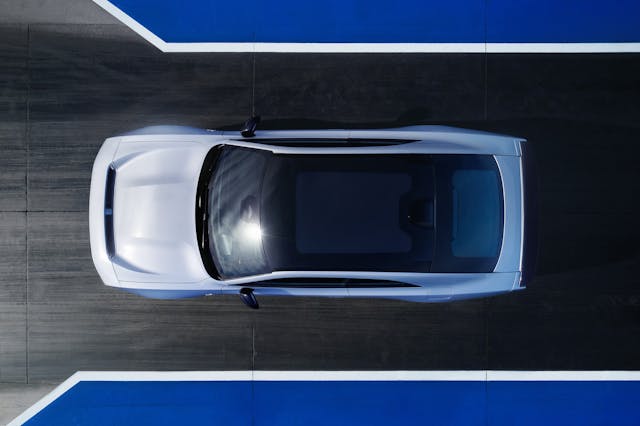
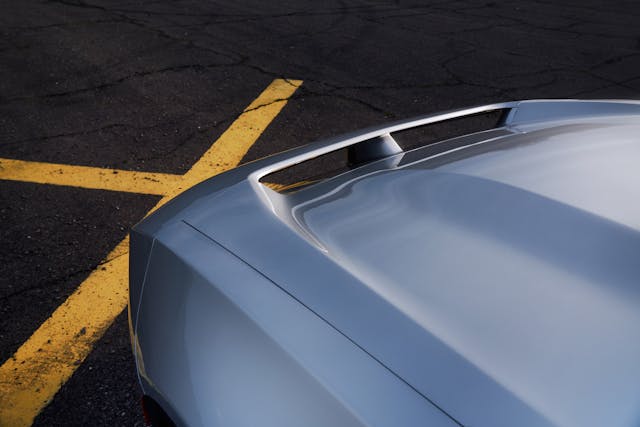
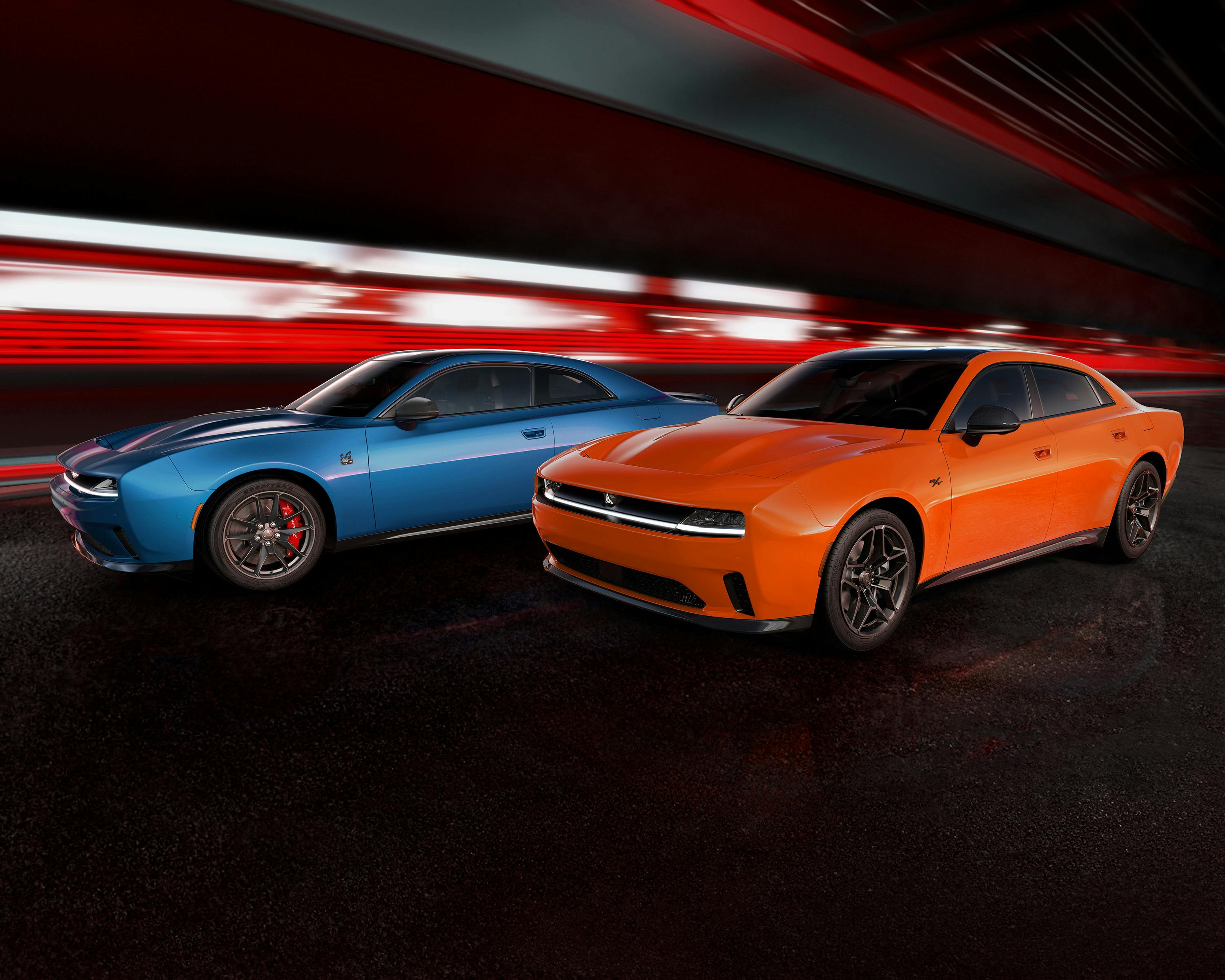
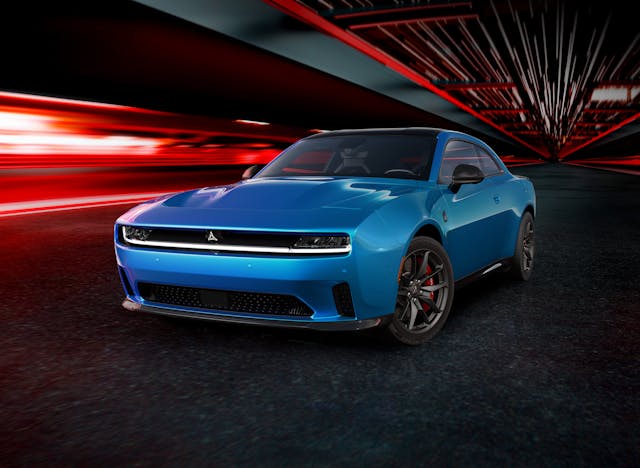

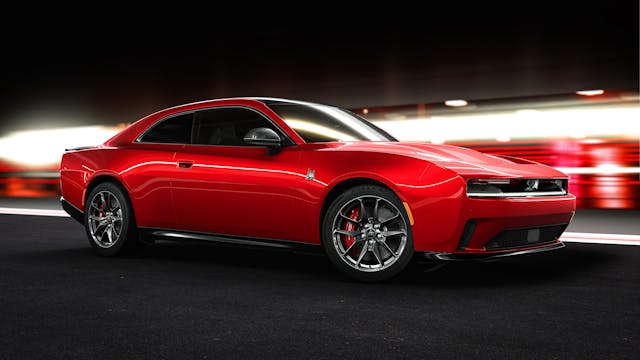
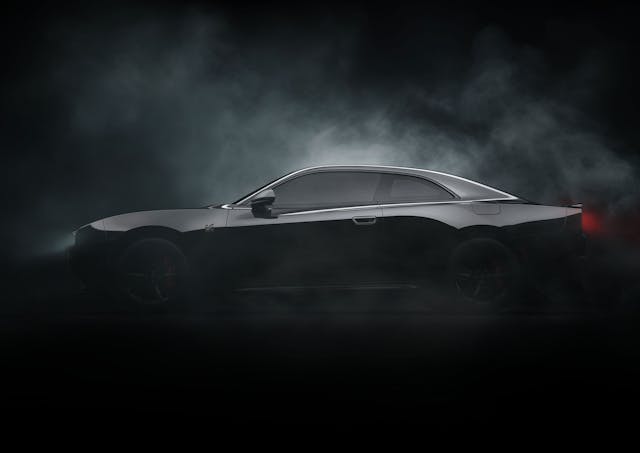
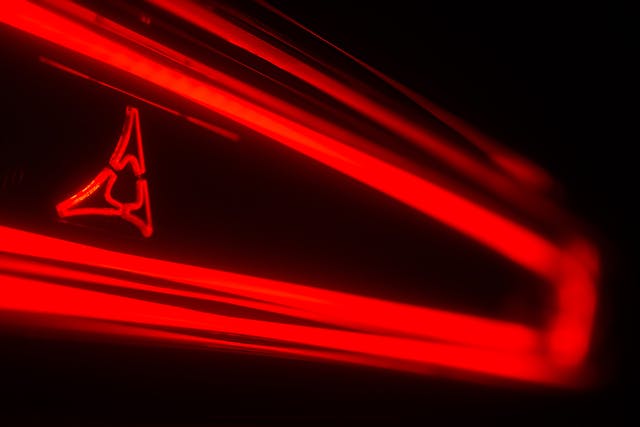
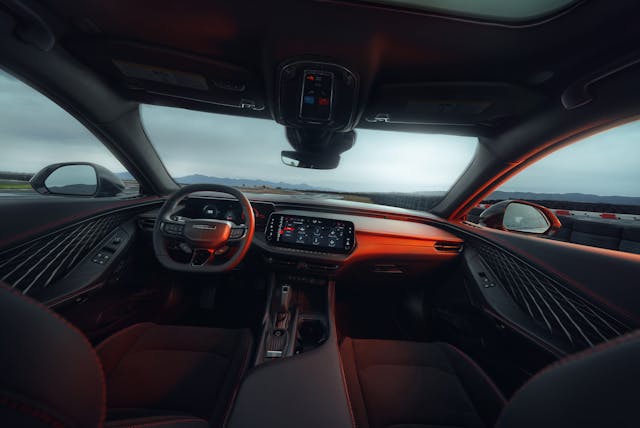



***
Check out the Hagerty Media homepage so you don’t miss a single story, or better yet, bookmark it. To get our best stories delivered right to your inbox, subscribe to our newsletters.
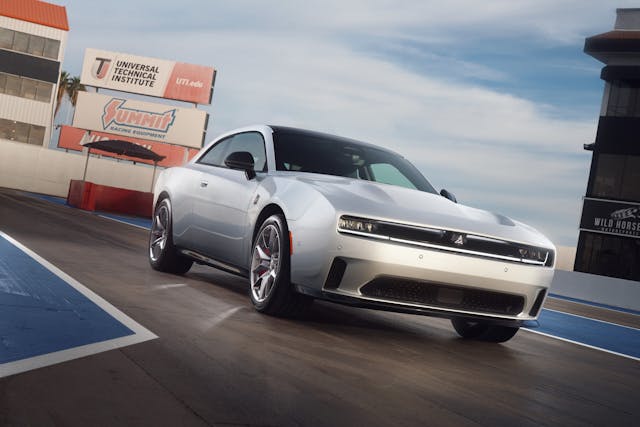


Pricing being “enthusiastically debated”???? Has anyone looked at the window sticker prices of the last of the 5.7 cars right now? I was 7 years into my last Charger RT – RT 5.7 hemi and looking to do another. I had two hemi Magnums before that. In August/September I could configure an exact replacement for my car at around $46,000. Up $5,000 but oh well. On the lots here locally, the window sticker for that same car is now $52,000-$56,000. For that price I went and bought a Cadillac CT5 twin turbo V6 which was also $56,000. Not paying Cadillac money for an end of game Dodge. So when it says they are debating the pricing on the new car they are really saying “how much can we over charge now that we are really the only game in town?” Expect it to be a lot, and more than they are worth. The only bright spot on it I guess is that if they can get strong money for these, MAYBE other car companies will jump back in the a performance coupe and sedan game. But Stellantis forgot their loyal customers in the pursuit of money and for me personally that will haunt my feelings for them for a long time, no matter how great the new ICE version of this car turns out to be.
Honestly, I’m a little hyped by this car. They finally got the Charger looks and door count right, albeit sans V8. The EV side is interesting enough, but I’d like to see how that I6-turbo pans out. Hopefully it’s a lot lighter. I wonder of the emissions/consumption of that 6 is all that much better than the V8 though. Its really a beautiful car inside and out. Much better looking that the new Mustang. Cost will determine a lot, but I bet the base car starts at 45k.
$45K? Dream on, buddy.
BOUT Damn time.. the last gen styling was a disgrace to the Charger name. Finally, a beautiful design with respectful cues from 1968!!
Weight, and more weight. Did I mention the weight?
This whole EV thing makes me want to Barf……………..
So now we have a 6000 lb Charger to park next to a 9000 lb GMC Hummer EV. And some people think they are saving the planet by driving these. I thought the 4400 lb Hemi Challenger was way too heavy. Maybe nobody cares about weight anymore.
True – look at the obesity epidemic for people in the USA. Why would most feel any differently about their cars?
I think once people test drive the EV model, they will soon forget about the gasser.
You would be wrong. A plug in appliance isn’t going to replace a gasser muscle car, for muscle car fans.
They will find out the hard way, just like Ford with that abomination, the Mach-e.
Does the Hellcat engine fit?
Darn good-looking, both in two-door and four-door form. The two-door in side profile definitely has a strong hint of the 1968-1970 Charger shape. And the interior, and the requisite screen, certainly does not look as obnoxious or overdone as in many cars – the new Mustang, for example.
Always interesting to read the comments about “no stick, no sale”. Manual transmissions are nearly extinct, and probably will become so within 5-10 years (with maybe the Miata excepted!) Surely these folks are not surprised when new models are automatic-only? For those so enamored of stick-shifts, better get one now, or hold on to the one you own now – as I plan to do with my Mustang GT.
RIP – Brotherhood of Muscle
Hope Dodge (and their new owner) enjoys all their lots full of this crap when it doesn’t sell…..
20 years from now…….Hey wow you have a 2024 electric “Charger with Scat pack”! Does it run? no they stopped making the battery 15 years ago…….Oh nice toxic paper weight….
You really think enthusiasts will just roll over after nearly a century of building their own parts? Hobby businesses have kept A LOT of cars alive over the years, be it making small batches of pistons, casting new engine blocks, or solving other problems that the manufactures never figured out. There is already repair businesses specializing in electrical repair and most car batteries today are built from smaller cells, therefore as battery tech advances it is not crazy to think there will be a way to produce battery packs that will keep these cars functioning.
Just because you don’t care does not mean no one does.
Have you even taken one of these batteries apart other than watching you tube videos? The control boards with outdated FPGAs. If you don’t know what FPGAs are read up. They are in everything. You can’t make them. Lets talk software to manage the charging and current control. The fabrication of the actual circuit cards? The cell archetecture and chemistry are not something that you can produce yourself. The business that you speak of only existist to remidy issues and not fix them. They clip failing cells out of the pack to fool the managment software. The repair yield is probably 15% at best with the rest unfixable due to circuit card component obsolescence or damage being the issue. Early Teslas had an issue with an outdated circuit card component. Take a computer or laptop or phone any thing with logic, wait 7 years and see if you can get parts. I’m talking electronic component level parts. And funny how you assume i’m against all this technology, far from that. I work in it. The biggest hurdle to electric vehicle is not range. Its standardizing the battery archetecture. Think about if everyone produced flashlights that took what every battery they felt they wanted to design. you would have landfills filled with discarded flashlights and batteries. EVs involved in accidents are a usually a complete loss therefore yielding no truly salvageable battery components since the battery is the entire bottom of the vehicle. take a wrecked ICE and you can recycle or harvest a large portion of the parts reducing new manufacturing of replacement parts. Comparing an ICE vehicle to an electric is apples to oranges. The tech moves so fast that without standardizing at least a battery design will keep filling our land with discarded failed electric vehicles. And recycling the battery also falls into that category. With that tech also constantly evolving we again will just build and throw away these cars like toasters. The ICE vehicles are around for decades for the exact thing you pointed out. A good machine shop can make you anything. You can cast anything. you can’t build semiconductors in your shed. And the enviromental impact of creating these semiconductors, circuit cards and finally the batteries are a major environmental impact. That is the same reason you don’t have many semiconductor or EV battery plants in the US any longer. I’m not at all against EVs. No oil to change, no transmission to rebuild , no catalytic converters to steal, brakes that last 100k miles no dependence on oil and wicked fast performance from instantaneous torque. People just look at an EV as a fluffy bunny that will fix everything.
I never said EV would fix everything, you and I agree that electric cars are not a solution for many situations but can be a solution for a few specific use cases.
Humans built the batteries and tech inside EVs. It was not dropped on us by some divine being. If we as a species built it once, what makes you think we cannot solve the same problem a second time with more advanced technology?
Just because you do not want to do it or it is not capable of being done with hand tools in a shed, does not make it impossible.
One more thing i like about EVs, no broken exhaust studs, cracked exhaust manifolds, and no rusted out mufflers , even though the rest of the system is good!!! I hate exhaust work and hold those that make a living off of it as gods!! I agree with you, one day this will be possible. cheers
There is a whole lot of Camaro in the front fenders and roof Y’all!!!!!!!!!!LOL
Told my wife yesterday “that’s more 69 Camaro RS in the front than Dukes Charger” –so I agree with you obviously. 😀
As Letterman used to say: You sir, have crystalized my thoughts eloquently: Except for the taillights, it looks like a Camaro to me too!; Both past and present Camaros. When Ford created the retro Thunderbird, Fiat the retro-500, Mini Cooper, the retro-Mini and VW the “New Beetle” they looked unmistakably like the original counterparts they were paying homage to. If you want me to buy a NEW 2-DOOR Dodge CHARGER it should resemble one. (Think about starting with a Dynacorn body with electric powertrain and go from there). I might have even tried listening to the fake exhaust sounds, since I enjoy the simulated ocean waves on my alarm clock. Who knows, I might even like fake exhaust sounds, if I could turn it off on days that I needed peace & quiet on my commute.
And on the environmental & techno arguments, I ditto what that Bill Scranton guy said. He sounds like he knows what he’s talking about…
I had a 69 Charger S/E and a 70 R/T S/E.
I miss them both.
A “Charger” with 4 doors, no V8, AWD and electric. Do it if you want but don’t hang it with the iconic Charger name tag. Ford did it with the iconic Mustang when they put on 2 more doors and an electric motor. Even Corvette will be coming out with electric and AWD. Call it zoom zoom putt put or anything but leave the iconic names alone. Atleast Challenger went out with a bang.